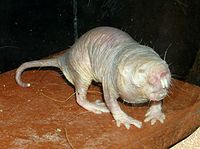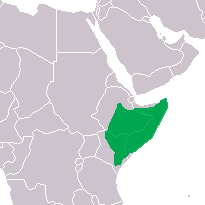Naked mole-rat
This article needs additional citations for verification. (January 2008) |
| Naked mole rat Temporal range: Early Pliocene - Recent
| |
|---|---|

| |
| Scientific classification | |
| Kingdom: | |
| Phylum: | |
| Class: | |
| Order: | |
| Family: | |
| Subfamily: | Heterocephalinae Landry, 1957
|
| Genus: | Heterocephalus Rüppell, 1842
|
| Species: | H. glaber
|
| Binomial name | |
| Heterocephalus glaber Rüppell, 1842
| |

| |
| Distribution of the Naked Mole Rat | |
The naked mole rat (Heterocephalus glaber), also known as the sand puppy, or desert mole rat is a burrowing rodent native to parts of East Africa and the only species currently classified in genus Heterocephalus. It is notable for its eusocial lifestyle, nearly unique among mammals (only the Damaraland mole rat shares the trait), and for a highly unusual set of physical traits that enables it to thrive in a harsh, underground environment; including a lack of pain sensation in its skin, and a nearly cold-blooded metabolism.
Physical description
Typical individuals are 8–10 cm long and weigh 30–35 g. Queens are larger and may weigh well over 50 g, the largest reaching 80 g. They are well-adapted for their underground existence. Their eyes are just narrow slits, and consequently their eyesight is poor. However, they are highly adapted to moving underground, and can move backwards as fast as they can move forwards. Their large, protruding teeth are used to dig. Their lips are sealed just behind their teeth while digging to avoid filling their mouths with soil. Their legs are thin and short. They have little hair (hence the common name) and wrinkled pink or yellowish skin.
The naked mole rat is well adapted for the limited availability of oxygen within the tunnels that are its habitat: its lungs are very small and its blood has a very strong affinity for oxygen, increasing the efficiency of oxygen uptake. It has a very low respiration and metabolic rate for an animal of its size, thus using oxygen minimally. In long periods of hunger, such as a drought, its metabolic rate can reduce by up to 25 percent.
The naked mole rat is unique among mammals in that it is virtually cold-blooded; it cannot regulate its body temperature at all and requires an environment with a specific constant temperature in order to survive.
The skin of naked mole rats lacks a key neurotransmitter called Substance P that is responsible in mammals for sending pain signals to the central nervous system. When naked mole rats are exposed to acid or capsaicin, they feel no pain. When injected with Substance P, however, the pain signaling works as it does in other mammals, but only with capsaicin and not with the acids. This is proposed to be adaptation to the animal living in high levels of carbon dioxide due to poorly ventilated living spaces, which would cause acid to build up in their body tissues.[1]
Longevity
The naked mole rat is also of interest because it is extraordinarily long-lived for a rodent of its size (up to 28 years). The secret of their longevity is debated, but is thought to be related to the fact that they can shut down their metabolism during hard times, and so prevent oxidative damage. Todd Karhu, an expert on the species, explains this by saying "They're living their life in pulses." ROMMIEROMMIEROMMIEROMMIEROMMIEROMMIEROMMIEROMMIEROMMIEROMMIEROMMIEROMMIEROMMIEROMMIEROMMIEROMMIEROMMIEROMMIEROMMIEROMMIEROMMIEROMMIEROMMIEROMMIEROMMIEROMMIEROMMIEROMMIEROMMIEROMMIEROMMIEROMMIEROMMIEROMMIEROMMIEROMMIEROMMIEROMMIEROMMIEROMMIEROMMIEROMMIEROMMIEROMMIEROMMIEROMMIEROMMIEROMMIEROMMIEROMMIEROMMIEROMMIEROMMIEROMMIEROMMIEROMMIEROMMIEROMMIEROMMIEROMMIEROMMIEROMMIEROMMIEROMMIEROMMIEROMMIEROMMIEROMMIEROMMIEROMMIEROMMIEROMMIEROMMIEROMMIEROMMIEROMMIEROMMIEROMMIEROMMIEROMMIEROMMIEROMMIEROMMIEROMMIEROMMIEROMMIEROMMIEROMMIEROMMIEROMMIEROMMIEROMMIEROMMIEROMMIEROMMIEROMMIEROMMIEROMMIEROMMIEROMMIEROMMIEROMMIEROMMIEROMMIEROMMIEROMMIEROMMIEROMMIEROMMIEROMMIEROMMIEROMMIEROMMIEROMMIEROMMIEROMMIEROMMIEROMMIEROMMIEROMMIEROMMIEROMMIEROMMIEROMMIEROMMIEROMMIEROMMIEROMMIEROMMIEROMMIEROMMIEROMMIEROMMIEROMMIEROMMIEROMMIEROMMIEROMMIEROMMIEROMMIEROMMIEROMMIEROMMIEROMMIEROMMIEROMMIEROMMIEROMMIEROMMIEROMMIEROMMIEROMMIEROMMIEROMMIEROMMIEROMMIEROMMIEROMMIEROMMIEROMMIEROMMIEROMMIEROMMIEROMMIEROMMIEROMMIEROMMIEROMMIEROMMIEROMMIEROMMIEROMMIEROMMIEROMMIEROMMIEROMMIEROMMIEROMMIEROMMIEROMMIEvROMMIEROMMIEROMMIEROMMIEROMMIEROMMIEROMMIEROMMIEROMMIEROMMIEROMMIE[2]
Due to their extraordinary longevity for such a small rodent, an international effort was put into place to sequence the genome of the naked mole rat. [3]
Conservation status
Naked mole rats are not threatened. Despite their tough living conditions, naked mole rats are quite widespread and numerous in the drier regions of East Africa. Though seen living up to 20 years, their lifestyles in those situations consist of mostly sleep.
In popular culture
- A naked mole rat named Rufus is featured in the Disney Channel cartoon Kim Possible.
- The Errol Morris documentary Fast, Cheap and Out of Control features a naked mole rat specialist.
- A children's book, The Naked Mole-Rat Letters, by Mary Amato, is about a young girl who sends fabricated e-mails to her father's girlfriend, a zookeeper.
- The consumer website Consumerama awards a weekly "Naked Mole-Rats of Marketing Award" for shameless consumer abuse.
References
- ^ Park, Thomas J. (2008). "Selective Inflammatory Pain Insensitivity in the African Naked Mole-Rat (Heterocephalus glaber)". PLoS Biology. 6 (1): e13. doi:10.1371/journal.pbio.0060013. PMID 18232734.
{{cite journal}}: Unknown parameter|coauthors=ignored (|author=suggested) (help)CS1 maint: unflagged free DOI (link) - ^ Ugly Duckling Mole Rats Might Hold Key To Longevity
- ^ Proposal to Sequence an Organism of Unique Interest for Research on Aging: Heterocephalus glaber, the Naked Mole-Rat
- Template:IUCN2006 Database entry includes a brief justification of why this species merits a "Least Concern" conservation status
- Dawkins, Richard. The Selfish Gene (30th anniversary edition ed.). Oxford University Press. 0-19-929115-2.
{{cite book}}:|edition=has extra text (help) - Foster KR and Ratnieks FLW (2005). A new eusocial vertebrate? Trends in Ecology & Evolution, 20(7): 363–364.
External links
- Page on the Animal Diversity Web
- An article on nursing from Cornell University
- Article from Walker's Mammals of the World
- Brookfield Zoo with photo
- More photos
- Heterocephalus glaber images at bioimages.vanderbilt.edu
- Naked Mole-rats Hold Clues to Human Aging - LiveScience.com
- Tool use by naked mole-rats
- Live video of a Naked Mole-rat colony housed in the Smithsonian National Zoological Park

